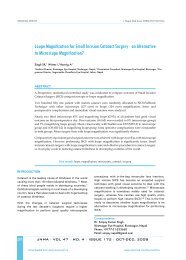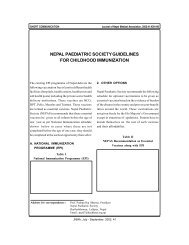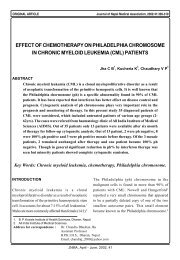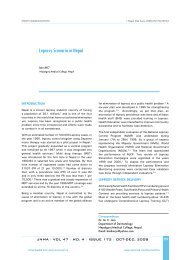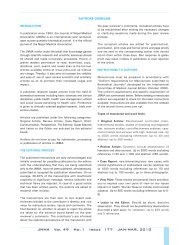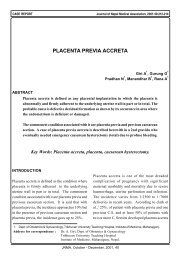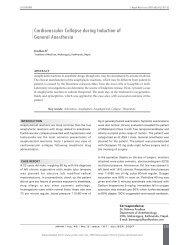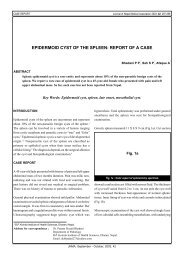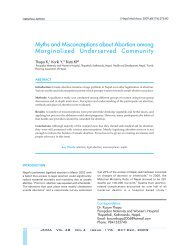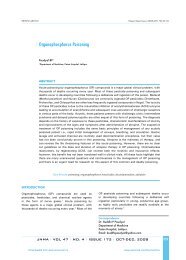F:\My Backup\brija\JNMA\JNMA (1 - Journal of Nepal Medical ...
F:\My Backup\brija\JNMA\JNMA (1 - Journal of Nepal Medical ...
F:\My Backup\brija\JNMA\JNMA (1 - Journal of Nepal Medical ...
Create successful ePaper yourself
Turn your PDF publications into a flip-book with our unique Google optimized e-Paper software.
ORIGINAL ARTICLE <strong>Journal</strong> <strong>of</strong> <strong>Nepal</strong> <strong>Medical</strong> Association 2004; 43: 185-186<br />
PARTIAL SEIZURES IN CHILDREN<br />
Jain N * , Mangal V *<br />
ABSTRACT<br />
Seizure disorders are the most prevalent serious neurological disease. Partial seizures are the most common<br />
form <strong>of</strong> seizures in children. This prospective study was carried out to determine the etiology and intracranial<br />
lesions in children with partial seizures. During the period <strong>of</strong> 3 years, 172 children with partial seizures (>2<br />
attacks) were included in the study. All children had contrast CT scan <strong>of</strong> head. About 70% <strong>of</strong> children had<br />
their first episode <strong>of</strong> seizure before 6 years <strong>of</strong> age. The most common type <strong>of</strong> seizures was complex partial<br />
and the most common lesion on CT scan head was ring enhancing lesion (56.07%). For diagnosis <strong>of</strong> partial<br />
seizures detail history and CT Scan <strong>of</strong> Head are essential.<br />
Key Words: Partial seizures, neurocyticercosis, Tuberculoma, CT scan.<br />
INTRODUCTION<br />
Epilepsy is defined as a randomly recurring symptom complex<br />
resulting from an episodic disturbance <strong>of</strong> CNS function,<br />
associated with an excessive, self limited, neuronal discharge.<br />
Variation in clinical manifestations result from variation in<br />
the portion <strong>of</strong> the brain involved. The incidence <strong>of</strong> epilepsy<br />
has been reported to range from 0.8% –1.1% 1 and<br />
approximately 50% <strong>of</strong> all cases <strong>of</strong> epilepsy start in childhood.<br />
As per international league against epilepsy (ILAE 1989) all<br />
epilepsy cases are classified into two categories e.g. partial<br />
seizures and generalized seizures. 2<br />
OBJECTIVE<br />
The aetiological factors <strong>of</strong> epilepsy differ markedly in children<br />
as compared to adults. This study was carried out for<br />
determining the underlying etiology on CT scan Head.<br />
MATERIAL AND METHOD<br />
The study was conducted prospectively over a three year period<br />
between Jan 2000-Dec. 2002 in the department <strong>of</strong> pediatrics,<br />
<strong>Nepal</strong>gunj <strong>Medical</strong> College, <strong>Nepal</strong>gunj, <strong>Nepal</strong>. 172 children<br />
with partial seizures defined as per I LAE. All these children<br />
had two or more than two attacks <strong>of</strong> unprovoked partial<br />
seizures. Children with neonatal convulsions, febrile<br />
convulsions and acute CNS infections were excluded. All the<br />
children were subjected to CT Scan <strong>of</strong> Head.<br />
RESULT<br />
Of the 172 children with partial seizures, 112 (65.11%) were<br />
male and 60 (34.88%) were females. The age <strong>of</strong> patients ranged<br />
between 6 months and 12 years. 69.8% <strong>of</strong> children (120/172)<br />
had their first episode <strong>of</strong> seizure before the age <strong>of</strong> six years.<br />
The seizures type were as follows:<br />
(a) Simple Partial 38 (22.09%)<br />
(b) Complex Partial 95 (55.23%)<br />
(c ) Partial Seizures with Secondary<br />
generalization 39 (22.67%)<br />
The aetiological pr<strong>of</strong>ile on CT Scan Head <strong>of</strong> partial seizures<br />
in these children is shown in table I.<br />
* <strong>Nepal</strong>gunj <strong>Medical</strong> College, B.P. Chowk, <strong>Nepal</strong>gunj, <strong>Nepal</strong>.<br />
Address for correspondence : Dr. Neeraj Jain<br />
27 Mangal Nagar Saharanpur, India - 247001<br />
Email: ishu12002@yahoo.com<br />
JNMA, July - August, 2004, 43
Jain et al. Partial Seizures in Children 186<br />
Intracranial lesions were detected in 107 out <strong>of</strong> 172 children<br />
and the most commonly observed lesions on CT Scan <strong>of</strong> head<br />
were ring enhancing lesions which were multiple in 06 children<br />
and single in 54 children. Of these 60 patients 22 were<br />
diagnosed as tuberculoma using radiological criteria and<br />
supportive evidence <strong>of</strong> tuberculosis elsewhere and remaining<br />
35 were treated as neurocyticercosis. Immunological tests for<br />
NCC and follow up CT scan were not done due to economic<br />
constraints.<br />
DISCUSSION<br />
Partial seizures in children represent a large percentage <strong>of</strong><br />
epilepsy requiring an accurate diagnosis for appropriate<br />
management. A study <strong>of</strong> a cohort <strong>of</strong> 440 children observed<br />
partial seizures constitute a large percent (41.7%) <strong>of</strong> seizure<br />
types in children. 3 In developing countries like <strong>Nepal</strong> partial<br />
epilepsy is reported to be more frequent in all age groups. 4<br />
Analysis from clinical data and investigations revealed that<br />
ring enhancing lesions as neurocyticercosis were the<br />
commonest lesion. This has also been observed by other studies 5<br />
CT studies <strong>of</strong> partial seizures in children are very helpful in<br />
detecting small intracranial lesions and are reported to have a<br />
higher yield than those observed with generalized epilepsy. 6<br />
Abnormal scans have identified in 60-70% children with<br />
partial seizures. 7 The findings <strong>of</strong> the present study are similar<br />
to other studies so far as the basic patterns <strong>of</strong> intracranial<br />
structural lesions are concerned. 8,10<br />
Thus partial seizures is the most common neurological disease<br />
<strong>of</strong> childhood, which causes great impact on the social as well<br />
as economic aspect <strong>of</strong> the under developed countries. Numerous<br />
relatively benign, episodic spells <strong>of</strong>ten are misdiagnosed and<br />
even treated as seizures. Therefore correct diagnosis and<br />
appropriate treatment should be more important.<br />
Lesions Number %<br />
Normal 65 37.79%<br />
Symptomatic 107 62.20%<br />
? Ring enhancing<br />
1. Single<br />
2. Multiple<br />
54<br />
06<br />
50.46%<br />
5.60%<br />
? Cortical infract 12 11.21%<br />
? Cerebral atrophy 10 9.34%<br />
? Dilated Ventricles 06 5.60%<br />
? Encephalomalacia 06 5.60%<br />
? Calcifications 04 3.73%<br />
? Brain tumor 02 1.86%<br />
? Gliosis 03 2.80%<br />
? Porencepnalic cyst 02 1.86%<br />
? Subdural effusion 02 1.86%<br />
JNMA, July - August, 2004, 43<br />
ACKNOWLEDGEMENTS<br />
We would like to thank Dr. S.K. Kanodia, Pr<strong>of</strong>. S.K. Jha for<br />
their suggestions and Dr. Rinki Kalra, Mr. Krishna Panthi,<br />
Mr. Raees Sahi and Mrs. Pratibha Chaudhari for computing<br />
this manuscript.<br />
REFERENCES<br />
1. Agrawal A., Aneja A., Taluka V. et. Al: Etiology <strong>of</strong> Partial Epilepsy.<br />
Indian pediatr. 1998; 35:49-52<br />
2. Commission on classification and Terminology <strong>of</strong> international<br />
league Against Epilepsy, Proposal for revised classification <strong>of</strong><br />
Epilepsies and Epileptic syndromes. Epilepsia. 1989;30:389-<br />
99<br />
3. Kramer U., nevoy. Neufeld MV. et al: Epidemiology <strong>of</strong> Epilepsy<br />
in childhood, a cohort <strong>of</strong> 440 patients. Pediatr. Neurology.<br />
1998; 18 (1):46-50<br />
4. Senanayaka N. Romer GC; Epidemiology <strong>of</strong> Epilepsy in<br />
developing countries, Bull. WHO. 1993;71:247-58<br />
5. Kapoor M., Talukder B, Chowdhary V. et al: Intra Cranial<br />
structural lesions in young Epileptics, a computed tomography<br />
study; Indian Pediatr 1998;35:537-41<br />
6. Misra S, Verma R, Lekhra OP.et al; CT observations in Partial<br />
Seizures. Neurology India. 1994;42:24-27<br />
7. Kalra V: Management <strong>of</strong> childhood epilepsy. Indian J Pediatr.<br />
2000 (SS): S12-S21<br />
8. Kumar R, Kumar A. Kohli N et al: Ring or disc like enhancing<br />
lesions in Partial Epilepsy in India. J Trop Pediatr: 1990;36:131-<br />
34<br />
9. Garg RK, Karak B. Sharma AM et al: Single CT (ring) lesions in<br />
Epilepsy. Indian J Pediatr. 1999;66:155-57<br />
10. Wadia RS, Makhale CN. Kelkar AV, et al: Focal Epilepsy in India<br />
with special reference to lesions showing ring or disc like<br />
enhancement on contrast CT. J. Neurol. 1987;50:1298-1301.<br />
?????



